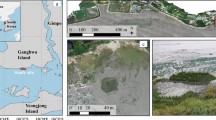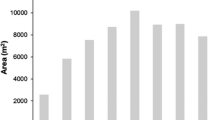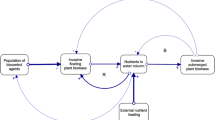Abstract
As invasive plants in different life stages have different recovery potential against devegetation operation, how to optimize the proper timing (the time for single treatment or the starting time for repeated treatments) for eliminating them becomes an important topic in the management of invasive plants. The invasive plant Spartina alterniflora was selected in this study, and it was clipped as a devegetation example to examine how important treatment timing is for increasing control efficiency. The results illustrated that by either single or repeated clipping treatments within 1 year, clipping at florescence was more efficient for controlling S. alterniflora. On the other hand, increasing clipping frequency without proper timing might not enhance control efficiency, suggesting that treatments in proper timing might reduce the clipping frequency required for a specific control target. From a management point of view, each control method has its optimal treatment timing, thus, in order to improve the control efficiency, the control programs should be ideally designed in relation to the phenology of the target plant. Besides, repeated clipping showed significantly higher control efficiency in low tidal zone than in high tidal zone, implying that habitat dependence of invasive plant control efficiency is an important issue in the management of invasive plants.



Similar content being viewed by others
References
An SQ, Gu BH, Zhou CF, Wang ZS, Deng ZF, Zhi YB, Li HL, Chen L, Yu DH, Liu YH (2007) Spartina invasion in China: implications for invasive species management and future research. Weed Res 47:183–191. doi:10.1111/j.1365-3180.2007.00559.x
Anonymous (1994) Spartina management program: integrated weed management for private lands in Willapa Bay, Pacific County, Washington. In Spartina task force. Washington, Pacific County
Ashman TL, Schoen DJ (1997) The cost of floral longevity in Clarkia tembloriensis: an experimental investigation. Evol Ecol 11:289–300. doi:10.1023/A:1018416403530
Augustine DJ, McNaughton SJ (1998) Ungulate effects on the functional species composition of plant communities: herbivore selectivity and plant tolerance. J Wild Manage 62:1165–1183. doi:10.2307/3801981
Bradford JB, Lauenroth WK (2006) Controls over invasion of Bromus tectorum: the importance of climate, soil, disturbance and seed availability. J Veg Sci 17:693–704. doi:10.1658/1100-9233(2006)17[693:COIOBT]2.0.CO;2
Brewer JS, Platt WJ (1994) Effects of fire season and herbivory on reproductive success in a Clonal Forb, Pityopsis-Graminifolia. J Ecol 82:665–675. doi:10.2307/2261273
Buckley YM, Bolker BM, Rees M (2007) Disturbance, invasion and re-invasion: managing the weed-shaped hole in disturbed ecosystems. Ecol Lett 10:809–817. doi:10.1111/j.1461-0248.2007.01067.x
Carroll SP (2007) Natives adapting to invasive species: ecology, genes, and the sustainability of conservation. Ecol Res 22:892–901. doi:10.1007/s11284-007-0352-5
Chapin F, Matson P, Mooney H (2002) Principles of terrestrial ecosystem ecology. Springer, Berlin Heidelberg New York
Chen ZY, Li B, Zhong Y, Chen JK (2004) Local competitive effects of introduced Spartina alterniflora on Scirpus mariqueter at Dongtan of Chongming Island, the Yangtze River estuary and their potential ecological consequences. Hydrobiologia 528:99–106. doi:10.1007/s10750-004-1888-9
Chung CH (2006) Forty years of ecological engineering with Spartina plantations in China. Ecol Eng 27:49–57. doi:10.1016/j.ecoleng.2005.09.012
Chung CH, Zhuo RZ, Xu GW (2004) Creation of Spartina plantations for reclaiming Dongtai, China, tidal flats and offshore sands. Ecol Eng 23:135–150. doi:10.1016/j.ecoleng.2004.07.004
Daehler CC, Strong DR (1994) Variable reproductive output among clones of Spartina alterniflora (Poaceae) invading San-Francisco Bay, California—the influence of herbivory, pollination, and establishment site. Am J Bot 81:307–313. doi:10.2307/2445457
DiTomaso JM, Kyser GB, Hastings MS (1999) Prescribed burning for control of yellow starthistle (Centaurea solstitialis) and enhanced native plant diversity. Weed Sci 47:233–242
Dozier H, Gaffney JF, McDonald SK, Johnson ERRL, Shilling DG (1998) Cogongrass in the United States: history, ecology, impacts, and management. Weed Technol 12:737–743
Emery SM, Gross KL (2005) Effects of timing of prescribed fire on the demography of an invasive plant, spotted knapweed Centaurea maculosa. J Appl Eco 42:60–69. doi:10.1111/j.1365-2664.2004.00990.x
Fisher AJ, DiTomaso JM, Gordon TR (2005) Intraspecific groups of Claviceps purpurea associated with grass species in Willapa Bay, Washington, and the prospects for biological control of invasive Spartina alterniflora. Biological control, pp 170–179
Grevstad FS (2002) Biological control of Spartina alterniflora in Willapa Bay, WA. Ecol Soc Am Annu Meet Abs 87:145
Grevstad FS (2005) Simulating control strategies for a spatially structured weed invasion: Spartina alterniflora (Loisel) in Pacific Coast estuaries. Biol Invasions 7:665–677. doi:10.1007/s10530-004-5855-1
Hammond MER (2001) The experimental control of Spartina Anglica and Spartina X Townsend II in estuarine salt marsh. PhD Thesis. University of Ulster, Ulster
Hastings A, Hall RJ, Taylor CM (2006) A simple approach to optimal control of invasive species. Theor Popul Biol 70:431–435. doi:10.1016/j.tpb.2006.05.003
He WS, Feagin R, Lu JJ, Liu WL, Yan Q, Xie ZF (2007) Impacts of introduced Spartina alterniflora along an elevation gradient at the Jiuduansha Shoals in the Yangtze Estuary, suburban Shanghai, China. Ecol Eng 29:245–248. doi:10.1016/j.ecoleng.2006.08.004
Hedge P, Kriwoken LK, Patten K (2003) A review of Spartina management in Washington State, US. J Aquat Plant Manage 41:82–90
Hoddle MS (2004) Restoring balance: using exotic species to control invasive exotic species. Conserv Biol 18:38–49. doi:10.1111/j.1523-1739.2004.00249.x
Huang ZY, Sun ZH, Yu K (1993) Bird resources and habitats in Shanghai. Fudan University Press, Shanghai
Hulme PE (2006) Beyond control: wider implications for the management of biological invasions. J Appl Ecol 43:835–847. doi:10.1111/j.1365-2664.2006.01227.x
Jing K, Ma ZJ, Li B, Li JH, Chen JK (2007) Foraging strategies involved in habitat use of shorebirds at the intertidal area of Chongming Dongtan, China. Ecol Res 22:559–570. doi:10.1007/s11284-006-0302-7
Li HP (2007) Ecological study on the controlling of an invasive alien plant Spartina alterniflora. PhD Thesis. East China Normal University, Shanghai
Li HP, Zhang LQ (2008) An experimental study on physical controls of an exotic plant Spartina alterniflora in Shanghai, China. Ecol Eng 32:11–21. doi:10.1016/j.ecoleng.2007.08.005
Li B, Liao CZ, Zhang XD, Chen HL, Wang Q, Chen Z Y, Gan XJ, Wu JH, Zhao B, Ma ZJ, Cheng XL, Jiang LF, Chen JK (2008) Spartina alterniflora invasions in the Yangtze River estuary, China: an overview of current status and ecosystem effects. Ecol Eng. doi:10.1016/j.ecoleng.2008.1005.1013
Lodge DM, Williams S, MacIsaac HJ, Hayes KR, Leung B, Reichard S, Mack RN, Moyle PB, Smith M, Andow DA, Carlton JT, McMichael A (2006) Biological invasions: recommendations for US policy and management. Ecol Appl 16:2035–2054. doi:10.1890/1051-0761(2006)016[2035:BIRFUP]2.0.CO;2
Ma ZJ, Li B, Jing K, Zhao B, Tang SM, Chen JK (2003) Effects of tidewater on the feeding ecology of hooded crane (Grus monacha) and conservation of their wintering habitats at Chongming Dongtan, China. Ecol Res 18:321–329. doi:10.1046/j.1440-1703.2003.00557.x
Malson K, Rydin H (2007) The regeneration capabilities of bryophytes for rich fen restoration. Biol Conserv 135:435–442. doi:10.1016/j.biocon.2006.10.017
Martin SG, Van Acker RC, Friesen LF (2001) Critical period of weed control in spring canola. Weed Sci 49:326–333. doi:10.1614/0043-1745(2001)049[0326:CPOWCI]2.0.CO;2
Metcalfe W, Ellison A, Bertness M (1986) Survivorship and spatial development of Spartina alterniflora Loisel. (Gramineae) seedlings in a New England salt marsh. Ann Bot (Lond) 58:249–258
Milligan AL, Putwain PD, Cox ES, Ghorbani J, Le Duc MG, Marrs RH (2004) Developing an integrated land management strategy for the restoration of moorland vegetation on Molinia caerulea-dominated vegetation for conservation purposes in upland Britain. Biol Conserv 119:371–385. doi:10.1016/j.biocon.2003.12.002
Myers JH, Simberloff D, Kuris AM, Carey JR (2000) Eradication revisited: dealing with exotic species. Trends Ecol Evol 15:316–320. doi:10.1016/S0169-5347(00)01914-5
Parker IM, Gilbert GS (2007) When there is no escape: the effects of natural enemies on native, invasive, and non-invasive plants. Ecology 88:1210–1224. doi:10.1890/06-1377
Pausas JG, Lloret F, Vila M (2006) Simulating the effects of different disturbance regimes on Cortaderia selloana invasion. Biol Conserv 128:128–135. doi:10.1016/j.biocon.2005.09.022
Pysek P, Krinke L, Jarosik V, Perglova I, Pergl J, Moravcova L (2007) Timing and extent of tissue removal affect reproduction characteristics of an invasive species Heracleum mantegazzianum. Biol Invasions 9:335–351. doi:10.1007/s10530-006-9038-0
Qin P, Xie M, Jiang YS, Chung CH (1997) Estimation of the ecological-economic benefits of two Spartina alterniflora plantations in North Jiangsu, China. Ecol Eng 8:5–17. doi:10.1016/S0925-8574(96)00227-3
Ramsey CL, Jose S, Miller DL, Cox J, Portier KM, Shilling DG, Merritt S (2003) Cogongrass [Imperata cylindrica (L.) Beauv.] response to herbicides and disking on a cutover site and in a mid-rotation pine plantation in southern USA. For Ecol Manage 179:195–207. doi:10.1016/S0378-1127(02)00515-7
Schooler S, Cook T, Bourne A, Prichard G, Julien M (2008) Selective herbicides reduce alligator weed (Alternanthera philoxeroides) biomass by enhancing competition. Weed Sci 56:259–264. doi:10.1614/WS-07-132.1
Schulz K, Thelen C (2000) Impact and control of Vinca minor L. in an Illinois forest preserve (USA). Nat Areas J 20:189–196
Stearns SC (1992) The evolution of life histories. Oxford University Press, New York
Theoharides KA, Dukes JS (2007) Plant invasion across space and time: factors affecting non-indigenous species success during four stages of invasion. New Phytol 176:256–273. doi:10.1111/j.1469-8137.2007.02207.x
Wang Q, An SQ, Ma ZJ, Zhao B, Chen JK, Li B (2006a) Invasive Spartina alterniflora: biology, ecology and management. Acta Phytotaxon Sin 44:559–588. doi:10.1360/aps06044
Wang Q, Wang CH, Zhao B, Ma ZJ, Luo YQ, Chen JK, Li B (2006b) Effects of growing conditions on the growth of and interactions between salt marsh plants: implications for invasibility of habitats. Biol Invasions 8:1547–1560. doi:10.1007/s10530-005-5846-x
Wang ZC, Zhang YM, Pan XY, Ma ZJ, Chen JK, Li B (2006c) Effects of winter burning and cutting on aboveground growth and reproduction of Spartina alterniflora: a field experiment at Chongming Dongtan, Shanghai. Biodivers Sci-China 14:275–283. doi:10.1360/biodiv.060072
Wardle DA, Bonner KI, Barker GM, Yeates GW, Nicholson KS, Bardgett RD, Watson RN, Ghani A (1999) Plant removals in perennial grassland: vegetation dynamics, decomposers, soil biodiversity, and ecosystem properties. Ecol Monogr 69:535–568
Weber E (2003) Invasive plant species of the world: a reference guide to environmental weeds. CABI, Wallingford
Wu MY, Hacker S, Ayres D, Strong DR (1999) Potential of Prokelisia spp. as biological control agents of English cordgrass, Spartina angelica. Biol Control 16:267–273. doi:10.1006/bcon.1999.0752
Xiong SJ, Nilsson C (1999) The effects of plant litter on vegetation: a meta-analysis. J Ecol 87:984–994. doi:10.1046/j.1365-2745.1999.00414.x
Acknowledgments
This work was supported by the National Basic Research Program of China (No. 2006CB403305), the National Natural Science Foundation of China (nos. 30670330 and 30870409) and the Program for New Century Excellent Talents in University (NCET-06-0364) funded by the Ministry of Education of China. We thank Chongming Dongtan National Natural Reserve and the students in our laboratories for their assistance in field sampling.
Author information
Authors and Affiliations
Corresponding author
About this article
Cite this article
Gao, Y., Tang, L., Wang, J. et al. Clipping at early florescence is more efficient for controlling the invasive plant Spartina alterniflora . Ecol Res 24, 1033–1041 (2009). https://doi.org/10.1007/s11284-008-0577-y
Received:
Accepted:
Published:
Issue Date:
DOI: https://doi.org/10.1007/s11284-008-0577-y




